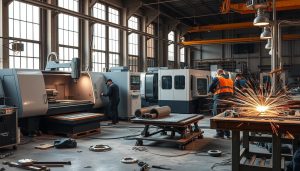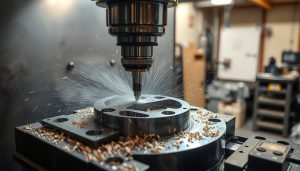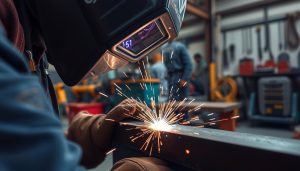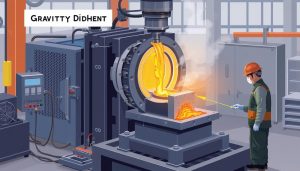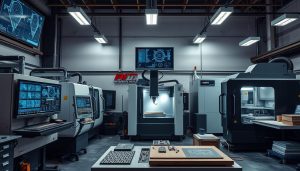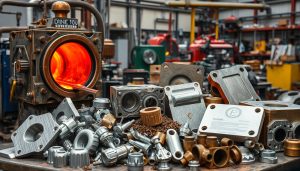In the dynamic landscape of modern manufacturing, laser cutting has emerged as a game-changing technology that is revolutionizing the way products are crafted. As the demand for precision, efficiency, and versatility continues to grow across various industries, understanding the pros and cons of this cutting-edge process has become increasingly crucial. This comprehensive overview will delve into the intricacies of laser cutting technology, exploring its strengths, limitations, and how it stacks up against other cutting methods in the manufacturing realm.
What is Laser Cutting?
Laser cutting is a versatile industrial manufacturing process that uses highly focused laser beams to precisely cut through a variety of materials. This technology has become increasingly popular in recent years, revolutionizing the way products are fabricated across numerous industries.
How Laser Cutting Works in Manufacturing
The laser beam cutting process involves directing a concentrated beam of light energy towards the material being cut. The intense heat generated by the laser melts or vaporizes the material, allowing for clean, accurate cuts. This process is commonly used for cutting metals, plastics, and other durable materials with great precision and efficiency.
Types of Laser Cutting Technology
- CO2 lasers – These lasers use carbon dioxide gas as the lasing medium and are known for their high power output, making them suitable for cutting thicker materials.
- Fiber lasers – Fiber lasers use a fiber optic cable as the lasing medium, offering improved beam quality, higher energy efficiency, and reduced maintenance requirements compared to CO2 lasers.
- Other laser technologies, such as solid-state lasers and disk lasers, are also used in the laser beam cutting process, each with their own unique characteristics and applications.
The choice of laser cutting technology is often determined by the specific requirements of the manufacturing project, including the type and thickness of the material, the desired level of precision, and the production volume.
“Laser cutting has revolutionized the way we manufacture products, enabling us to achieve unprecedented levels of precision and efficiency in a wide range of industries.”
Pros of Laser Cutting
Laser cutting technology offers a range of benefits that make it a preferred choice for precision manufacturing and efficient production. From its unparalleled accuracy to its versatility in handling complex designs, laser cutting consistently outperforms traditional cutting methods.
High Precision and Accuracy in Cutting
One of the primary advantages of laser cutting is its remarkable precision and accuracy. The laser beam can be precisely controlled, allowing for intricate cuts with tolerances as tight as 0.1 millimeters. This level of precision is essential for producing high-quality parts and components, ensuring a perfect fit and finish in various industries, from aerospace to medical equipment manufacturing.
Speed and Efficiency for Mass Production
Laser cutting systems are renowned for their lightning-fast processing speed, making them highly efficient for mass production. The laser’s ability to cut through materials quickly and with minimal material waste translates to increased productivity and reduced manufacturing costs. This speed advantage is particularly beneficial for businesses seeking to meet tight deadlines or scale up their production capacity.
Ability to Cut Complex Shapes and Intricate Designs
The versatility of laser cutting technology allows for the creation of complex shapes and intricate designs that would be challenging or even impossible to achieve with traditional cutting methods. From delicate patterns to curved and irregular shapes, laser cutting provides the flexibility to bring even the most ambitious design concepts to life, unlocking new possibilities for product innovation and customization.
Minimal Material Waste and Reduced Costs
Laser cutting’s precision and efficiency also contribute to reduced material waste, which in turn leads to cost savings for manufacturers. By minimizing scrap and optimizing material usage, laser cutting enables a more cost-effective production process, making it a favorable choice for businesses seeking to optimize their manufacturing costs.
| Benefit | Description |
|---|---|
| Precision Cutting | Laser cutting offers unparalleled accuracy, with tolerances as tight as 0.1 millimeters, ensuring high-quality parts and components. |
| Efficient Manufacturing | The speed and productivity of laser cutting systems make them highly efficient for mass production, allowing businesses to meet tight deadlines and scale up production. |
| Complex Designs | Laser cutting provides the flexibility to create intricate designs and complex shapes that would be challenging or impossible with traditional cutting methods. |
| Cost-effective Production | By minimizing material waste and optimizing usage, laser cutting enables a more cost-effective manufacturing process, benefiting businesses seeking to reduce their production costs. |
“Laser cutting technology has revolutionized the manufacturing industry, offering unparalleled precision, speed, and versatility that traditional methods simply cannot match.”
Cons of Laser Cutting
While laser cutting offers numerous advantages, it also comes with its fair share of limitations and drawbacks. Understanding these cons is crucial when considering laser cutting for your manufacturing needs.
Material Limitations and Thickness Restrictions
Laser cutting is primarily suitable for thin, flat materials such as metals, plastics, and some fabrics. Thicker materials can be challenging to cut, as the laser’s power may not be sufficient to penetrate deeply, leading to incomplete cuts or uneven edges. Laser cutting limitations include the inability to effectively process materials with high thermal conductivity, such as copper and aluminum.
High Initial Setup Costs for Equipment
Investing in a laser cutting machine can be a significant financial burden for many businesses. Equipment costs for laser cutting systems can be high, especially for more advanced models with features like automatic feeding, precision controls, and cutting-edge laser technology. This upfront investment can be a barrier for small-to-medium-sized enterprises looking to adopt laser cutting.
Risk of Material Distortion and Burn Marks
The intense heat generated by the laser can sometimes lead to material distortion or undesirable burn marks on the workpiece, particularly with thicker or more fragile materials. This can impact the overall quality and finish of the final product, requiring additional post-processing steps to address these issues.
Safety Concerns and Equipment Maintenance
Laser cutting systems require strict safety protocols and proper maintenance to ensure their safe and effective operation. Safety precautions are crucial, as the high-powered laser beam can pose a significant risk to operators if not handled correctly. Regular maintenance of the equipment is also necessary to maintain optimal performance and prevent potential malfunctions or accidents.
By understanding the limitations and drawbacks of laser cutting, manufacturers can make informed decisions about when and how to best utilize this technology within their production processes.

Comparing Laser Cutting with Other Cutting Methods
In the manufacturing world, laser cutting has become a popular choice for its precision and efficiency. However, it is not the only cutting method available. To help you make an informed decision, let’s explore how laser cutting compares to other cutting techniques, such as plasma and waterjet cutting.
Laser Cutting vs. Plasma Cutting
Plasma cutting is a thermal cutting process that uses a high-temperature plasma arc to melt and cut through metal. While plasma cutting is generally faster and can handle thicker materials than laser cutting, it often produces a larger kerf (the width of the cut) and a rougher edge finish. Laser cutting, on the other hand, offers superior precision and a cleaner cut, making it ideal for intricate designs and delicate parts.
Laser Cutting vs. Waterjet Cutting
Waterjet cutting utilizes a high-pressure stream of water, sometimes mixed with an abrasive material, to cut through a variety of materials. Unlike laser and plasma cutting, waterjet cutting does not rely on heat, which means it can handle a wider range of materials, including heat-sensitive and soft materials. However, waterjet cutting is generally slower and less precise than laser cutting, especially for complex shapes and thinner materials.
Advantages and Disadvantages of Each Method
| Cutting Method | Advantages | Disadvantages |
|---|---|---|
| Laser Cutting |
|
|
| Plasma Cutting |
|
|
| Waterjet Cutting |
|
|
When it comes to choosing the right cutting method for your manufacturing needs, it’s essential to weigh the pros and cons of each technique and select the one that best aligns with your specific requirements, such as material type, thickness, complexity, and production volume.

When to Use Laser Cutting in Manufacturing
Laser cutting is a versatile manufacturing solution that offers a range of advantages in various industries. From precision engineering to intricate design work, this technology can be a game-changer for businesses looking to improve their production processes. Let’s explore the best applications for laser cutting and the industries that benefit most from this innovative approach.
Best Applications for Laser Cutting Technology
- Cutting complex shapes and intricate patterns: Laser cutting excels at producing highly detailed, complex designs with tight tolerances, making it ideal for applications such as architectural models, electronic components, and decorative elements.
- Prototyping and small-batch production: The speed and precision of laser cutting make it a valuable tool for rapid prototyping, allowing businesses to quickly test and refine their designs before moving to full-scale manufacturing.
- Precision metal fabrication: Laser cutting is particularly well-suited for cutting high-precision metal parts, such as those used in aerospace, automotive, and medical equipment manufacturing.
- Engraving and marking: Laser cutting can be used for precise engraving and marking on a variety of materials, including metals, plastics, and glass, making it useful for creating personalized products, barcodes, and serial numbers.
Industries That Benefit Most from Laser Cutting
- Aerospace and Defense: Laser cutting is widely used in the aerospace and defense industries for producing complex, high-precision metal components and parts.
- Automotive: The automotive industry utilizes laser cutting for manufacturing a wide range of parts, from intricate dashboard elements to lightweight body panels.
- Electronics and Electrical: Laser cutting is essential for producing delicate, intricate components found in electronic devices, circuit boards, and electrical equipment.
- Architecture and Design: Architects and designers rely on laser cutting to create detailed models, prototypes, and decorative elements for their projects.
- Metalworking and Fabrication: Laser cutting is a go-to solution for metalworking and fabrication businesses, as it offers unparalleled precision and efficiency in cutting a variety of metal materials.
By understanding the best applications and the industries that stand to benefit the most from laser cutting, businesses can make informed decisions about integrating this powerful technology into their manufacturing processes, unlocking new possibilities for innovation, efficiency, and growth.
| Industry | Key Applications | Advantages of Laser Cutting |
|---|---|---|
| Aerospace | Aircraft components, satellite parts, defense equipment | High precision, complex shapes, minimal material waste |
| Automotive | Body panels, dashboards, exhaust systems | Speed, efficiency, intricate designs |
| Electronics | Circuit boards, casings, connectors | Precision, small feature sizes, delicate materials |
| Architecture | Models, signage, decorative elements | Detailed cutting, versatile material options |
| Metalworking | Fabricated parts, custom metal products | High-quality cuts, reduced production time |
“Laser cutting has revolutionized the way we approach manufacturing, allowing us to push the boundaries of what’s possible in terms of precision, efficiency, and product innovation.”
How to Choose the Right Laser Cutting Service
When it comes to selecting a reliable laser cutting service, there are several key factors to consider. The right choice can make all the difference in ensuring precision, efficiency, and cost-effectiveness for your manufacturing needs.
Evaluating Precision, Speed, and Material Compatibility
The first step is to assess the service provider’s capabilities in terms of precision, production speed, and material compatibility. Look for a company that can deliver laser cutting with exceptional accuracy, tailored to your specific requirements. Additionally, consider their turnaround times and ability to handle a wide range of materials, from thin sheets to thick plates.
Factors to Consider for Cost-Effectiveness and Quality
Beyond technical capabilities, it’s essential to evaluate the overall cost-effectiveness and quality of the laser cutting service. Compare pricing models, additional fees, and any volume discounts to ensure you’re getting the best value. Additionally, review the service provider’s quality assessment processes and track record of delivering high-quality results.
To help you make an informed decision, consider the following checklist when choosing a laser cutting service:
- Precision and accuracy of laser cutting
- Production speed and turnaround times
- Compatibility with a diverse range of materials
- Transparent pricing and cost-effective solutions
- Robust quality assurance measures
- Positive customer reviews and industry reputation
By carefully evaluating these factors, you can find a laser cutting service that aligns with your manufacturing needs and delivers cost-effective, high-quality results.
“Choosing the right laser cutting service can be a game-changer for your manufacturing process. It’s not just about the technology – it’s about finding a partner who can understand your unique requirements and deliver exceptional quality and value.”
Why Choose Shixinproto for Laser Cutting Services?
Shixinproto is a leading provider of professional Shixinproto laser cutting services, offering cutting-edge technology and a commitment to quality that sets us apart. With years of experience in the industry, our team of experts is dedicated to delivering custom laser cutting solutions tailored to the unique needs of our clients across various sectors.
At Shixinproto, we pride ourselves on our state-of-the-art Shixinproto laser cutting equipment and stringent quality control processes. Our advanced technology allows us to achieve unparalleled precision, speed, and efficiency, ensuring that your projects are completed to the highest standards. Whether you require intricate designs or large-scale production, our professional manufacturing services are designed to meet your needs with unwavering precision and attention to detail.
Choosing Shixinproto means partnering with a company that is committed to your success. Our team of experts will work closely with you to understand your specific requirements and develop customized solutions that maximize the benefits of Shixinproto laser cutting technology. With our focus on cost-effectiveness and quality, you can trust Shixinproto to deliver exceptional results that exceed your expectations.
